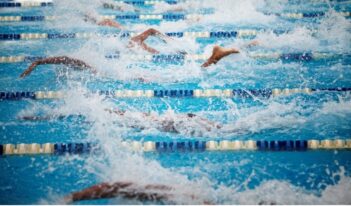
Scholar proposes federal oversight of youth sports to protect athletes’ health and promote equity in ahtletics.
The youth sports industry in the United States generates nearly $20 billion a year, exceeding major sports leagues’ annual profits. Though child athletes are on the fields and courts generating revenue for industry stakeholders, the federal government has yet to regulate youth sports.
In an article published in the Virginia Sports and Entertainment Law Journal, N. Jeremi Duru, a professor at Washington College of Law, argues that national regulation of youth sports is necessary to protect young athletes from mental and physical harm. Duru proposes a federal council to address the risks that child athletes face and to develop standards for the youth sports industry.
Duru contends that “early sport specialization, spectator incivility, and socioeconomic stratification” harm young athletes and occur with little to no government oversight to prevent such harm.
Parents or coaches may push young athletes to specialize in one sport. The parental push for early specialization stems from parents’ belief that equates specialization with better performance and a higher chance to earn college admission. This specialization typically results in highly focused training, which precludes children from participating in other sports.
Early specialization has negative physical and emotional impacts on children, Duru notes. For example, kids who specialize in one sport early have an increased risk of injury from overuse of the same muscle groups. In addition, early specialization leads to adverse mental health consequences, such as increased levels of anxiety, depression, social isolation, and burnout.
Duru argues that intensity in youth sports extends to the spectators. The tense atmosphere at youth sports events often results in friction among the stakeholders present at the game, such as parents, coaches, and officials. Sometimes, these interactions turn violent.
Duru concedes that some youth sports organizations have attempted to self-regulate negative spectator behavior. For example, the American Youth Soccer Organization once required that parents of the players sign “comportment agreements” for their children to participate. The agreements included provisions that mandated parents show respect to one another and not engage in unsportsmanlike conduct.
Duru also recognizes the high cost barriers to youth sports participation. Although some parents can spend thousands of dollars a year to help their children earn spots on competitive teams or to fund travel to games, many parents are unable to do so.
Children from low-income households are less than half as likely to participate in youth sports compared with children from higher socioeconomic positions. Children from low-income households may also experience declines in physical health, a higher likelihood of participating in youth crime, and poorer academic outcomes when they are precluded from participating in sports.
Duru argues that federal regulators should take action to reform youth sports in the United States by creating a federal commission to regulate the industry. Duru suggests that the government establish a new branch of the the U.S. Department of Health and Human Services or develop a new, independent agency or council, which he proposes calling the National Youth Sports Council (NYSC).
Duru insists that the NYSC should “coordinate federal efforts on youth sports to ensure consistent messaging and to further the government’s engagement in sports.” Duru argues that the goal of the NYSC should be that all children are afforded the opportunity to engage in youth sports and to maximize the mental and physical benefits of sports.
Specifically, Duru suggests that the NYSC should have four focus areas to achieve its goal: parental education; athlete well-being; civility; and socioeconomic considerations.
Duru proposes that all youth sports organizations host mandatory educational meetings for parents at the start of each season, which would include topics, such as orthopedic and pediatric safety guidelines for the sport, examples of uncivilized spectator conduct, and information about penalties for nonadherence to NYSC standards.
According to Duru, the NYSC would also set limits on the time a child can participate in a particular sport yearly and weekly to protect athlete well-being. For example, the NYSC would prevent children from playing one sport for more than nine months a year and would require that children rest at least one day each week. Duru intends for these limits to curb both the physical and mental impacts of overexertion in youth sports.
Under Duru’s proposal, NYSC regulations would institute consequences for poor behavior from spectators, such as fines or expulsion from games. The NYSC would require parents to sign a “civility pledge,” vowing good sportsmanship at games. Duru further suggests that parents would pay a “civility fee” to the organization each season that the organization could return to parents only if the parents do not violate their civility pledges.
Finally, Duru proposes that federal funding for youth sports would come in the form of grants to lessen the barrier to participation for low-income youth. Duru suggests that individual states that have legalized sports gambling could use that tax revenue to subsidize youth sports for low-income children.
Duru emphasizes that his proposals are the minimum of what the government should do to reform youth sports, and that individual organizations should have more stringent standards.
Children deserve to benefit from youth sports safely, sustainably, and equitably and stronger federal oversight of the industry would achieve this outcome for child athletes across the United States, according to Duru.



